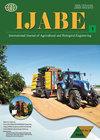不同灌溉方式下生菜田氮氧化物排放对灌溉下限的响应
IF 2.2
2区 农林科学
Q2 AGRICULTURAL ENGINEERING
International Journal of Agricultural and Biological Engineering
Pub Date : 2023-01-01
DOI:10.25165/j.ijabe.20231604.7961
引用次数: 0
摘要
灌溉对耕地N2O和NO排放有显著影响,但不同灌溉方式下灌溉下限之间的N2O或NO排放差异尚未得到很好的比较。在一个灌溉莴苣田,设计了3个DR(滴灌)下限,包括75% (DR1)、65% (DR2)和55% (DR3)田间容量,以及1个FI(沟灌)下限(65%田间容量)。测定了N2O和NO排放通量与土壤氮形态,并分析了这些指标之间的线性相关关系。结果表明:在相同灌溉方式下,沟灌处理的氮氧化物和一氧化氮排放量比滴灌处理分别增加了36.8%和45.2%;DR3下N2O和NO的累积排放量分别比DR1下高30.2%和28.6%。4个处理中,DR1处理土壤NO3——N浓度最低。N2O和NO排放通量与土壤NH4+-N (r=0.88和0.76)或NO2——N (r=0.90和0.80)浓度的相关性强于土壤NO3——N和可溶性有机氮,说明N2O和NO主要由土壤硝化过程产生。在灌溉方式相同的情况下,滴灌比沟灌的N2O和NO排放更低。此外,与大配额低频率滴灌相比,小配额高频率滴灌减少了N2O和NO的排放。关键词:一氧化二氮,一氧化二氮,滴灌,沟灌,土壤氮DOI: 10.25165/ j.j ijabe.20231604.7961引用本文:侯明明,肖勇,朱庆勇,陈建宁,黄辉,金强,等。不同灌溉方式下生菜田氮氧化物排放对灌溉下限的响应农业与生物工程学报,2023;16(4): 159 - 167。本文章由计算机程序翻译,如有差异,请以英文原文为准。
NxO emissions in response to the irrigation lower limits under different irrigation modes in a lettuce field
Irrigation has a significant impact on NxO (N2O and NO) emissions from cultivated land, yet the N2O or NO emission among the irrigation lower limits under different irrigation modes has not been well compared. In an irrigated lettuce field, three DR (drip irrigation) lower limits were designed, including 75% (DR1), 65% (DR2) and 55% (DR3) field capacity, and one FI (furrow irrigation) lower limit (65% field capacity). The N2O and NO emission fluxes and soil nitrogen (N) forms were determined, and the linear correlation between these indicators was analyzed. Results showed that under the same irrigation regime, the N2O and NO emissions from furrow irrigation treatment increased by 36.8% and 45.2% respectively compared to that from drip irrigation treatment. The cumulative N2O and NO emissions under DR3 were 30.2% and 28.6% higher than under DR1, respectively. Moreover, DR1 was also the lowest among the four treatments in soil NO3--N concentration. The N2O and NO emission fluxes were more correlated to soil NH4+-N (r=0.88 and 0.76) or NO2--N (r=0.90 and 0.80) concentration than soil NO3--N and soluble organic N, indicating that N2O and NO were mainly produced by the soil nitrification process. When the irrigation regime was the same, N2O and NO emissions were lower with drip irrigation than with furrow irrigation. Besides, drip irrigation with small quota but high frequency reduced N2O and NO emission compared to that with large quota but low frequency. Keywords: nitrous oxide, nitric oxide, drip irrigation, furrow irrigation, soil nitrogen DOI: 10.25165/j.ijabe.20231604.7961 Citation: Hou M M, Xiao Y, Zhu Q Y, Chen J N, Huang H, Jin Q, et al. NxO emissions in response to the irrigation lower limits under different irrigation modes in a lettuce field. Int J Agric & Biol Eng, 2023; 16(4): 159–167.
求助全文
通过发布文献求助,成功后即可免费获取论文全文。
去求助
来源期刊

International Journal of Agricultural and Biological Engineering
AGRICULTURAL ENGINEERING-
CiteScore
4.30
自引率
12.50%
发文量
88
审稿时长
24 weeks
期刊介绍:
International Journal of Agricultural and Biological Engineering (IJABE, https://www.ijabe.org) is a peer reviewed open access international journal. IJABE, started in 2008, is a joint publication co-sponsored by US-based Association of Agricultural, Biological and Food Engineers (AOCABFE) and China-based Chinese Society of Agricultural Engineering (CSAE). The ISSN 1934-6344 and eISSN 1934-6352 numbers for both print and online IJABE have been registered in US. Now, Int. J. Agric. & Biol. Eng (IJABE) is published in both online and print version by Chinese Academy of Agricultural Engineering.
 求助内容:
求助内容: 应助结果提醒方式:
应助结果提醒方式:


